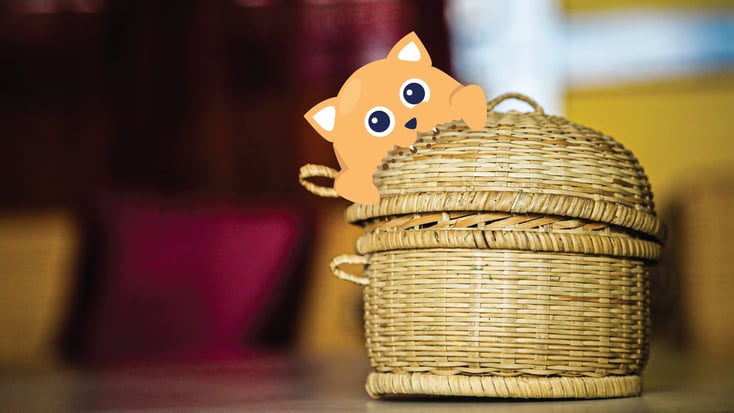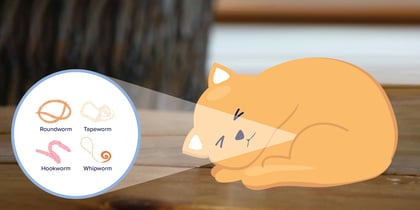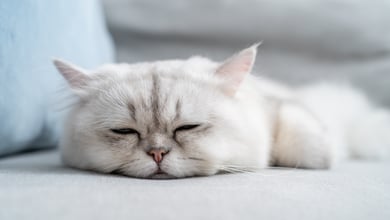Pica in Cats: Causes, Symptoms, & Treatments

Table of Contents
As an in-home veterinary practice, one of the common questions we encounter is about cats with pica, which is the consumption of non-edible household items.
Read on to learn more about the causes, symptoms, diagnosis, and treatment of pica in cats.
Key Takeaways:
- Pica in cats is a condition where they consume non-edible household items.
- Behavioral, environmental, or medical factors can cause it.
- Veterinary care from BetterVet can help diagnose and treat pica in cats, preventing potential health consequences.
What is Pica in Cats?
Pica in cats is a condition where they exhibit the behavior of consuming non-edible household items. This can include chewing on objects like plastic or rubber and licking and chewing home surfaces such as walls or floors. It can be either behavioral or medical in nature and may lead to serious health consequences if left untreated.
Causes of Pica in Cats
Pica in cats can stem from various underlying causes, including behavioral, environmental, or medical factors. Behavioral pica may occur due to boredom in your cat, anxiety, or can develop as a form of attention-seeking behavior.
Environmental factors such as stress or exposure to toxins can also trigger pica in cats. Cats may also develop pica if they are not fed adequately or are on a highly restrictive diet. Younger cats and some breeds are more susceptible to developing feline pica, such as:
- Siamese cats
- Oriental short-haired cats
- Tonkinese cats
Medical conditions, including some common cat diseases that may cause feline pica, include:
- Nutritional deficiencies
- Anemia
- Gastrointestinal disorders
- Endocrine disorders such as hyperthyroidism
- Feline immunodeficiency virus (FIV)
- Feline leukemia (FeLV):
- Dental disease
- Neurological disease
Signs & Symptoms of Pica in Cats
Symptoms resulting from or associated with cats with pica may vary depending on the underlying cause and the type of non-food item ingested. The most common signs include:
- Vomiting
- Diarrhea or constipation
- Drooling
- Abdominal pain
- Loss of appetite
- Consumption of non-edible objects
- Behavioral shifts
If your cat chews or ingests non-food items like plastic or rubber, they may become at risk for a gastrointestinal obstruction, which can be a life-threatening emergency.
Additionally, pica can lead to behavioral alterations in your cat, such as heightened restlessness, a tendency to hide, or increased aggression.
Diagnosis of Pica in Cats
To diagnose the underlying cause(s) of pica in cats, your veterinarian may perform various tests, including blood tests, to check for nutritional deficiencies or endocrine disorders. Your veterinarian may also perform an X-ray or ultrasound to rule out gastrointestinal obstructions.
If the cause of pica is suspected to be behavioral, your veterinarian may refer you to a pet behaviorist to address the underlying issue.
Pica in Cats Treatment
Treating pica in cats depends on the underlying condition(s) leading to this behavior. If the cause is medical, treating the underlying cause may resolve the pica behavior.
For instance, if a cat is diagnosed with a nutritional deficiency, providing supplements or switching to a different diet may help resolve the condition. In cases where the cat has ingested items like plastic or rubber, your veterinarian may recommend surgical removal of the object.
Behavioral pica can be treated by addressing the underlying behavioral issue through environmental enrichment, behavior modification, or medication.
How to Stop Pica in Cats
Addressing pica in cats involves minimizing access to non-edible items and attending to underlying causes. Here's how:
Limit access
Minimize your cat's exposure to non-edible items, especially items that are easily ingested or pose a choking hazard.
Medical evaluation
Consult a veterinarian to rule out any medical issues causing pica. Nutritional deficiencies or other health problems can contribute to this behavior.
Balanced diet
Ensure your cat receives a well-balanced and nutritious diet that meets their specific nutritional needs. Your vet can recommend the appropriate diet based on your cat's age, weight, and health status.
Environmental enrichment
Provide plenty of mental and physical stimulation for your cat. Interactive toys, scratching posts, climbing trees, and hiding places can prevent boredom and the urge to chew on non-edible items.
Regular playtime
Engage your cat in daily play sessions using toys that encourage mental and physical activity. This helps redirect their energy and reduces the likelihood of pica.
Behavioral modification
Consult your veterinarian for behavioral guidance if it's due to these types of issues. They can recommend behavior modification techniques to address stress, anxiety, or compulsive behaviors.
Supervision
Keep a watchful eye on your cat, especially in new environments or situations. Swiftly intervene if you notice them attempting to ingest non-edible items.
How BetterVet Can Help Cats with Pica
Pica is a cat disorder with severe health consequences if left untreated. The condition's underlying cause may be behavioral, medical, or environmental. A thorough workup is necessary to reach a diagnosis and select appropriate and effective treatment.
If you notice signs, including vomiting, diarrhea, or constipation, resulting from pica in your cat, visit your veterinarian for diagnosis and treatment.
Frequently Asked Questions
What are some common things that cats with pica eat?
Cats with feline pica often exhibit a tendency to consume various common household items. These may include fabric, elastic, cardboard, paper, plastic, wool, plaster, and even soil.Can pica in cats be cured?
Pica in cats can be cured if the underlying cause of the behavior is identified and addressed. Treatment may involve medication, dietary changes, environmental enrichment, or surgery.
Is pica in cats dangerous?
Pica in cats can be dangerous if the cat ingests items like plastic or rubber, which can lead to gastrointestinal obstruction. If you suspect your cat has swallowed one of these items, seek veterinary attention immediately.
Can pica in cats be a sign of a nutritional deficiency?
Yes, pica in cats can be a sign of a nutritional deficiency. Cats may consume non-food items to compensate for their diet’s lack of essential nutrients. A veterinarian can perform blood tests to determine if a cat has a nutritional deficiency and recommend the appropriate treatment.
Can pica in cats be prevented?
Pica in cats can be prevented by providing a balanced and nutritious diet, providing environmental enrichment, and addressing any underlying medical or behavioral issues. Pet parents should also ensure that their cats do not have access to non-edible items that they may ingest.






